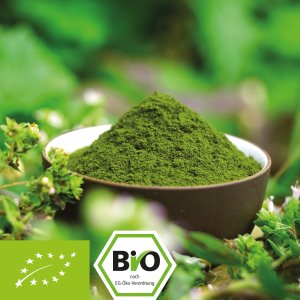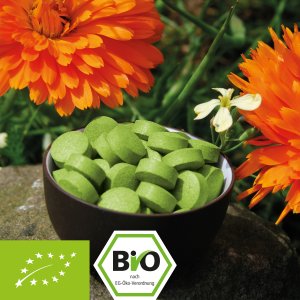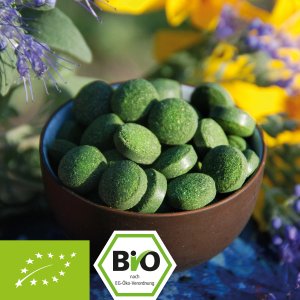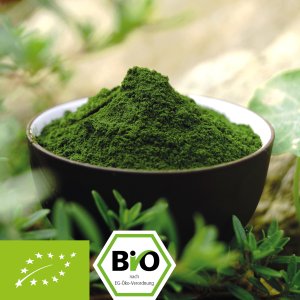Barley Grass? What Is It and What Exactly Do You Do With It?
You hear these questions again and again in conversations, because for most people the term Barley Grass (Bio) is, as a rule, uncharted territory. We therefore begin with an explanation of the term and then continue with a historical overview. Finally, you will find information on the health benefits and effects of barley grass.
Barley grass - from grain to harvest:
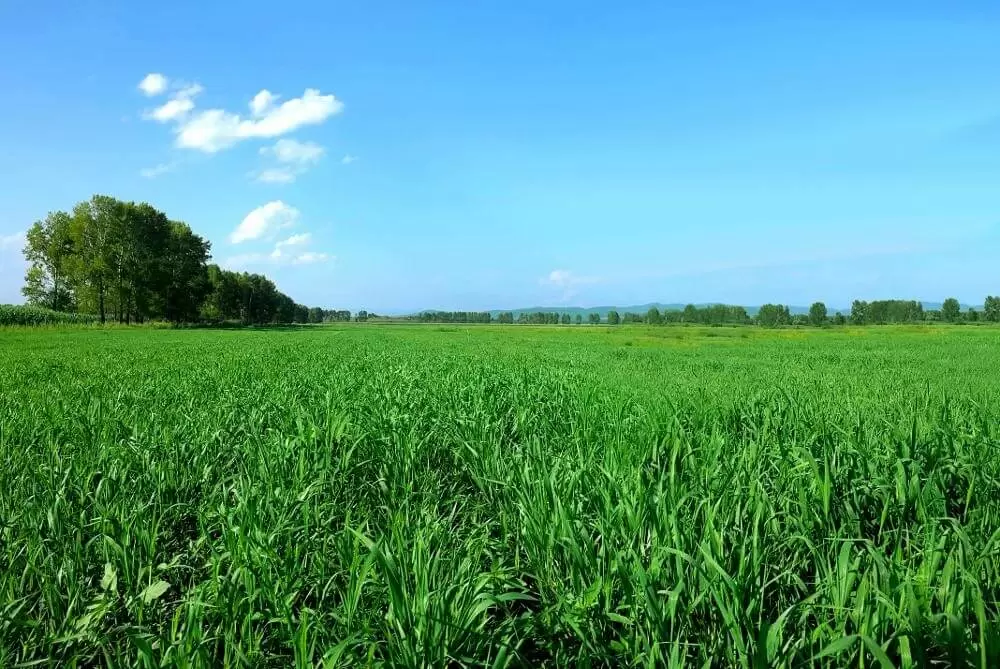
Barley grass field shortly before harvesting
From a biological point of view, barley grass is the young barley plant from the germination stage to the so-called sprouting stage, i.e. the point at which the plant begins to form ears. During this period, the plant goes through various stages of growth.
Germination begins after the grain has been planted in the soil, with the first small roots breaking out and after 6-9 days the first cotyledons appear on the ground.
The next stages are leaf development and tillering. This is when the main root begins to develop and absorb nutrients and the plant, under the influence of sunlight, grows more leaves and begins photosynthesis. The effects of photosynthesis are explained in more detail in the following section. :)
At the end of the tillering phase, barley grass has the highest nutrient content and tastes the sweetest. This is the time when the barley grass is harvested and immediately gently dried in order to preserve all the nutrients, enzymes and secondary plant substances. It is then processed into powder or pellets.
You can also easily grow barley grass and wheat grass yourself at home. The following YouTube tutorial shows you how.
BarleyBarley Grass (Bio) - a small powerhouse of nature
To explain the high nutrient content of barley grass, we need to take a closer look at the process of photosynthesis and how it works within the plant.
Photosynthesis is the process by which the plant converts solar energy into growth energy.
You can think of the barley grass plant as a small solar power plant. The chlorophyll contained in the plant is able to absorb the sun's energy, which is then used to break down water and carbon dioxide and convert it into glucose and oxygen.
The glucose is then used, together with nitrogen, sulphur and various minerals and trace elements, to form cellulose, proteins and fats, the substances that barley grass needs to grow.
This ultimately explains why barley grass is so rich in nutrients. Due to the favorable time of harvest, the plant consists almost exclusively of young leaves rich in chlorophyll and has not yet expended any energy to produce the substance that the leaves need to supply.

But why barley grass?
Barley (Hordeum vulgare L.) belongs to the sweet grass family and was probably first cultivated by humans around 10,000 years ago in Mesopotamia, the Mesopotamian region between the Euphrates and Tigris rivers.
From then on, barley played a prominent role in the human diet. Historical sources report its cultivation by the ancient Egyptians as well as later by the Sumerians and Babylonians. In ancient China, barley was already considered a sacred plant 5,000 years ago.
The use of barley grass today is mainly due to the research of the Japanese scientist and pharmacologist Dr. Yoshihide Hagiwara goes back. He became interested in the effects of cereal grasses and barley grass in particular after he visited the Japanese peninsula of Chita and learned from a farmer there that he was feeding his cows rye grass instead of normal pasture grass and that they were producing milk for much longer as a result.
He then began researching over 200 green plants and discovered that barley grass had a unique nutrient profile and a unique nutrient density.
The high protein content of 20-25%, which is made up of all 8 essential amino acids, i.e. precisely the protein building blocks that the body cannot produce itself, is particularly noteworthy.
But also the following vitamins, minerals and trace elements that can be found in barley grass powder.
Our Green Trio consists of one third each of organic barley grass, organic spirulina and organic chlorella.
BarleyBarley Grass (Bio) - nutrients for all situations in life or 'What effect does barley grass have?
Iron - or - barley grass is good for the blood:
The body needs iron to transport oxygen around the body. This makes iron one of the most important substances in the body, as it influences the metabolism, the immune system, the growth and regeneration of skin and hair, and much more.
10g of barley grass powder contains almost 4mg of iron, almost half of the daily requirement of 10mg.
With 10g of barley grass powder you also cover the daily requirement of beta-carotene and vitamin K and 50% of the vitamin B2 (riboflavin) required by the body.
Beta-carotene:
Beta-carotene is the precursor of vitamin A and is required in the human body for a number of processes. These include the regeneration of nerve cells, protein metabolism and cell regeneration. It therefore also has a positive effect on the immune system.
Vitamin K:
Like vitamin A,vitamin K is a fat-soluble vitamin and is involved in the blood clotting process. It is also required for cell growth and bone metabolism. Studies also suggest that vitamin K counteracts vascular calcification.
Vitamin B2 (riboflavin):
Is a water-soluble vitamin and is involved in most metabolic processes.
Barley grass also contains:
Potassium:
Potassium is the nerve and muscle mineral. It has a balancing effect on the water balance of the cells, is responsible for the transmission of stimuli in the nerves and controls muscle contraction.
Calcium:
An adequate supply of calcium is particularly important for the development of bones and teeth, but calcium is also important for muscle and metabolic function.
Zinc:
Zinc is essential for the body and is needed for the immune system and metabolism. It is also necessary for cell growth and the formation of genetic material.
Barley grass is therefore particularly suitable for vegetarians, vegans or people with increased nutritional requirements, e.g. vegan bodybuilders and other athletes, to supplement their diet in a natural and healthy way.
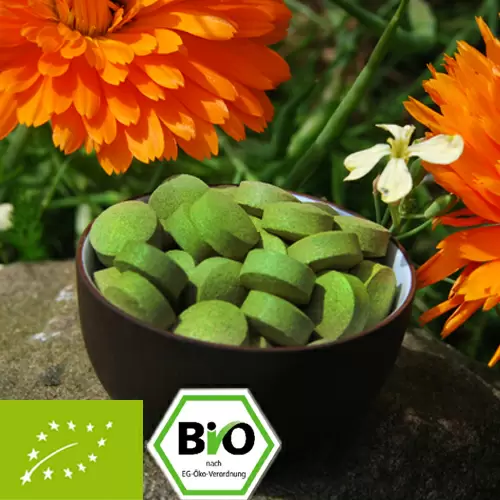
BarleyBarley Grass (Bio) - healthy gut - healthy person! -The effect on the digestive system
Barley grass can be an enrichment not only for active people. Even in times of rest and regeneration, natural, plant-based food supplements such as barley grass, but also, for example spirulina or chlorellaa welcome support.
Many people enjoy the benefits of fasting. therapeutic fasting is now very popular. As a rule, solid foods are completely avoided and instead, while reducing the amount of calories, liquid foods such as juices, teas and broths are often used.
Nowadays, Wheat Grass (Bio) or barley grass juice is often used to provide the body with the necessary nutrients.
However, it is not only the ingredients that the body absorbs that are important, but also the fiber, which is abundant in barley grass powder, plays an important role. Fibres are indigestible carbohydrates and stimulate intestinal activity on the one hand and promote the development of healthy intestinal flora on the other.
Japanese studies have shown that barley grass or sprouted barley can also have a positive effect on ulcerative colitis due to its high fibre content, as it supports the repair of the epithelial cells of the intestine and, as already described above, helps to increase the population of healthy intestinal bacteria.
Other health effects are now also being researched. At the Maharaja Sayajirao University in India, a study on the effect of barley grass on diabetes mellitus (type 2).
In this study, the researchers came to the conclusion that barley grass powder can certainly have a positive effect because, at the end of the test period, the harmful LDL cholesterol had decreased and the levels of positive HDL cholesterol had increased in the test subjects and both the blood sugar levels and the HbA1c values (used to determine long-term blood sugar) were lower than at the start of the test phase.
This is consistent with the results of a Taiwanese study from 2002, which also suggests that barley grass has a positive effect on type 2 diabetes.
The same research group also investigated the antioxidant effect of barley grass in people with elevated LDL cholesterol levels and came to the conclusion that both the cholesterol levels fell and the cell oxidation caused by LDL cholesterol decreased.
Bitter substances and antioxidants in barley grass:
Barley grass not only contains macro- and micronutrients but also other substances that contribute to health.
The best-known antioxidants currently found in barley grass are the superoxide dismutases (SOD). This is the generic term for a group of different enzymes that are able to convert hyperoxides into hydrogen peroxides, i.e. to counteract cell oxidation.
Barley grass powder also contains the flavonoid 2'-O-glycosylisovitexin2'-O-GIV for short, which, according to a study by the University of California, has a greater antioxidant effect than vitamin E.
The differences between barley grass powder and barley grass juice powder:
The biggest difference between barley grass and barley grass juice powder is basically the processing and the resulting ingredients.
While the entire stalk of barley grass is processed, which means that fiber is retained, only the juice pressed from the stalks is processed in barley grass juice powder, as the name suggests.
Of course, this presents the farmer with a much greater challenge, because with this type of processing it is particularly important to observe the timing and to process the product quickly so that the ingredients and therefore the positive effect are not lost.
There are many reasons for this. In sunny and dry weather, freshly harvested barley grass begins to dry out very quickly, as it has no natural protective layer, such as an orange, and also lacks the necessary volume that other vegetables, such as carrots or tomatoes, have. This naturally affects the yield. In addition, if the temperature is too high after harvesting, the raw vegetable quality would be lost. In this case, harvesting should take place either in the early morning or evening or even at night.
In damp or rainy weather, there is a risk that the microbiological limits will be exceeded and the entire harvest will no longer be usable.
It is therefore important for both barley grass powder and barley grass juice powder to be dried or pressed immediately after harvesting. This also has the advantage that more ingredients are retained.
While the processing of barley grass is relatively simple, as it is only dried and ground, processing it into barley grass juice powder is much more complex and requires a great deal of expertise, as you naturally want to obtain a product that is of raw food quality and complies with food law/analytical standards.
When processing to raw food quality, a temperature of no more than 38-42 degrees is generally assumed.
The first processing step after harvesting barley grass juice powder is pressing with large screw presses, which contain sensors for constant temperature monitoring and thus control the speed and thus the pressure and friction of the press at all times. This ensures that the temperatures never exceed the critical value and that a direct juice of raw food quality is obtained. The barley grass juice is then immediately cooled further to ensure that it remains fresh.
The next crucial step is processing into powder. This requires gentle drying.
Various methods are available for this: spray drying, vacuum drying and freeze drying.
All three methods are suitable for keeping the drying temperature below the critical value of 42 degrees Celsius. The effect of drying the barley grass too hot should not be underestimated, as the protein structure begins to denature above 42 degrees Celsius.
As a rule, however, spray drying has established itself for this critical area, as it is particularly suitable for liquids. Freeze-drying and vacuum drying are generally used for solids such as vegetables or fruit.
Some suppliers advertise that their barley grass juice powder is supposedly dried using CO2. This process is known as supercritical drying.
However, this is more commonly used for solids and hardly plays a role in food processing.
This statement is therefore an advertising promise and is not a process that is actually used to obtain powder from juices.
Ultimately, it is important that the temperature is kept below 42 degrees and that processing is carried out quickly so that all valuable ingredients such as vitamins, enzymes and proteins are retained and are not damaged in any way.
As you can easily see, the different processing steps result in different end products with different effects. Whereas in barley grass powder the dietary fibers make up a large part of the powder, barley grass juice powder contains almost no dietary fibers. This should be taken into account when choosing a product.
Until a few years ago, the only high-quality barley grass juice powder came from our partner in the USA, as they had the corresponding patented technology for fast and nutrient-preserving processing.
After many years of tinkering, we have now finally succeeded in producing an equally high-quality product in Europe.
Recently, we have also started sourcing a rich green barley grass juice powder from a farmer in Austria.
Excellent barley grass grows here in the picturesque landscape of Lower Austria, which is harvested and processed at the peak of its nutrient concentration.
For the time being, only small quantities of this product are available, so unfortunately we can only supply it in 100g quantities, which makes it all the more valuable.
Further information:
For more information on the effects of barley grass, its history and scientific significance, we recommend Barbara Simonsohn's book "Barley Grass Juice", which you can read in part here.
In our blog and advice section you will find creative recipe ideas and recipe videos all about barley grass.
Chia bread with barley grass
Colorfulsushi variations
Green Smoothie Bowl
Smoothie with barley grass Chia and Baobab
Vitamin C smooth ie with aspermill rosehip & barley grass
Raspberry-banana protein smoothie with barley grass juice powder and pumpkin seed protein
Green breakfast with barley grass juice powder
Green shake with Aspermill barley grass juice powder or Chlorella Algae (Bio)
Green dessert with Aspermill barley grass powder and chia seeds
DIY - Coloring eggs with turmeric, blueberries and barley grass
Eeeeee what do I see... Coloring eggs in the Aspermühle
Avocado lemon cake with barley Barley Grass (Bio) & thyme
You can also find recipe videos here.
Smoothie with barley grass, chia and baobab
